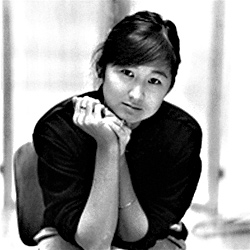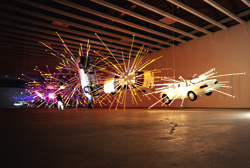Young architecture student Maya Lin flinched and bowed her head as a Vietnam veteran stood before an audience and derided her design for the Vietnam Veterans Memorial as an “insulting, demeaning . . . black scar.” This moment was captured in Freida Lee Mock’s 1995 Academy Award–winning documentary about the artist, Maya Lin—A Strong Clear Vision.
Lin was a 21-year-old senior at Yale in 1981 when her design for the Vietnam Veterans Memorial was selected from over 1,400 submissions in a national competition. It was controversial at the time—a war memorial with no heroic statue of a soldier marching in triumph, nor American flag waving eternally in bronze. It was considered, at the very least, disrespectful. Even Lin’s Asian-American background was grounds for debate. At the dedication ceremony in 1982, Lin was not even named. Yet, over time, the sleek, powerful black granite wall, half-embedded in the earth and simply etched with the names of the 57,661 fallen soldiers, has become one of the most emotionally stirring and frequently visited war memorials in the nation.
Since then, the youngest child of Chinese-American English and art professors has become an internationally recognized artist who has applied her sensitivity, acuity, and skill at honing unyielding slabs of stone into poignant memorials, buildings, and sculptures. For the Civil Rights Memorial in Montgomery, Ala. (1989), a veil of water flows over a circular stone table bearing the names of 40 people who died fighting for racial justice between 1954 and 1968, giving a tangible quality to the otherwise intangible emotions of hope and loss.
Now 46, Lin is turning her insight and chisel to a place closer to home for Pacific Northwesterners in The Confluence Project, a series of seven sites along the Columbia River following the trail of Lewis and Clark across Washington and Oregon. The mixed history of the two white explorers trailblazing through Native American land should provide fertile ground for Lin’s incisive skill at both acknowledging and assuaging conflicting emotions attached to places and moments in American history.
On April 20, she will deliver the Henry Art Gallery’s Annual Distinguished Artist Lecture, in which she will discuss her accompanying exhibit of new sculpture at the museum (“Systematic Landscapes,” through Sept. 3) and her ambitious new undertaking along the Columbia River.
Maya Lin appears Thurs., April 20, at Henry Art Gallery, UW campus, 15th Avenue Northeast and Northeast 41st Street, 206-543-2280, www.henryart.org.








